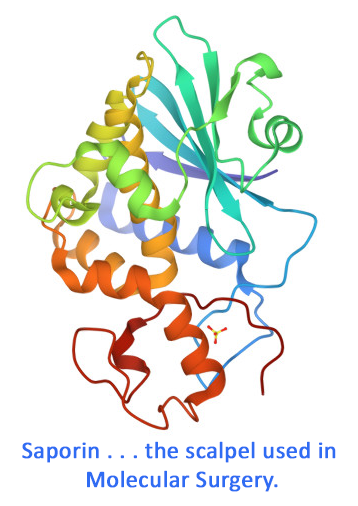SSP-SAP is a conjugation of saporin and SSP, the Sar9, Met(O2)11 analog of Substance P. These two amino acid replacements are at two sites of digestion by tissue proteases (there is a third that is still in the analog, so it does eventually get degraded). Since the targeting agent is, of course, necessary for the cytotoxic activity, SSP-SAP will diffuse farther, and thus hit more target cells. This specific analog of SP-saporin resists peptidase digestion, allowing a greater diffusion from the injection site before its metabolism. SSP-SAP eliminates cells expressing the Substance P (NK-1) receptor. Behaviors associated with pain perception are greatly affected by the injection of SSP-SAP into the spinal cord of rats. It is not suitable for retrograde transport.
SSP-SAP is also being used to replace SP-SAP (Cat. #IT-07). Scientific advisors have given counsel for this replacement because SSP-SAP is a superior lesioning agent in many situations, due to its targeting vehicle, a protease-resistant form of substance P. An excellent example is the paper by Martin and Sloviter, J Comp Neurol 436:127-152 (2001), in which after ineffective intraparenchymal injection of SP-SAP in the hippocampus, SSP-SAP was used with tremendous efficacy. In almost all applications we expect SSP-SAP will be used at a lower dose than SP-SAP.
Limited Label License: This product is the subject of claims in a U.S. patent entitled “Substance P-Saporin (SP-SAP) Conjugates and Methods of Use Thereof” (6,063,758 and 7,741,435), owned by Advanced Targeting Systems, Inc. Purchase of this product conveys to the buyer only the non-transferable right under this patent to use the product in research conducted by the buyer.
SSP-SAP is available individually (Cat. #IT-11) or as a kit (Cat. #KIT-11) which includes SSP-SAP and Blank-SAP (Cat. #IT-21).
keywords: saporin, analog, Substance P, SP, NK-1R, NK-1 receptor, NK1R, SSP, Stable Substance-P, pain, peptidease-resistant, interneurons, hippocampus, neocortex, Spinal cord lamina I neurons, brain, neuroscience, temporal lobe epilepsy


Reviews
There are no reviews yet.